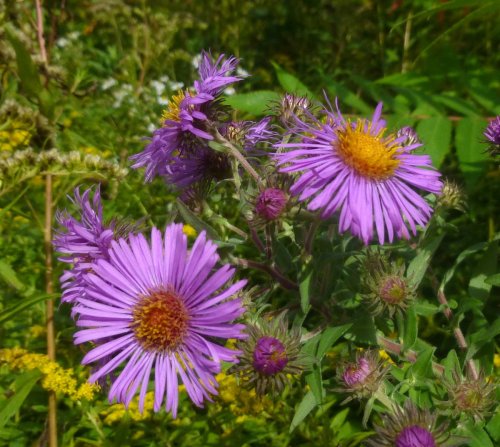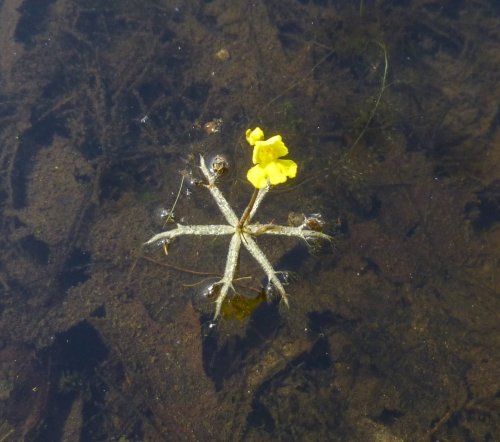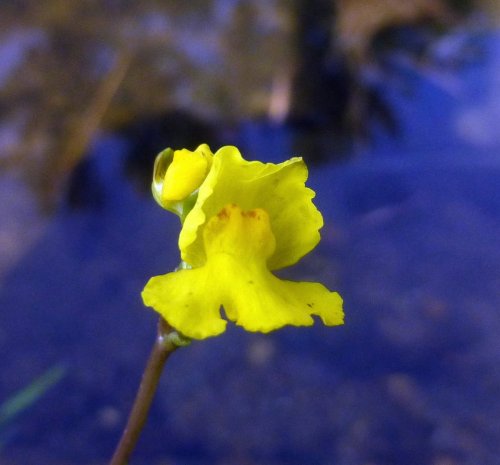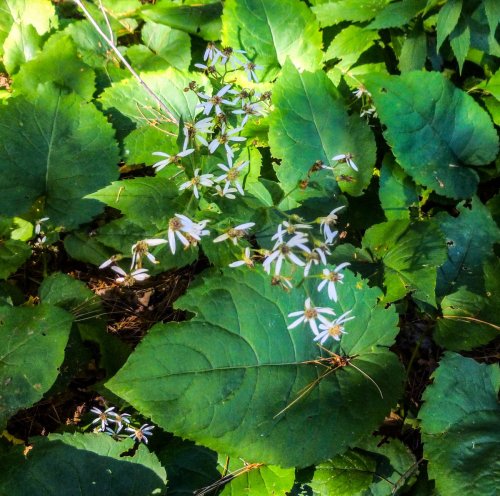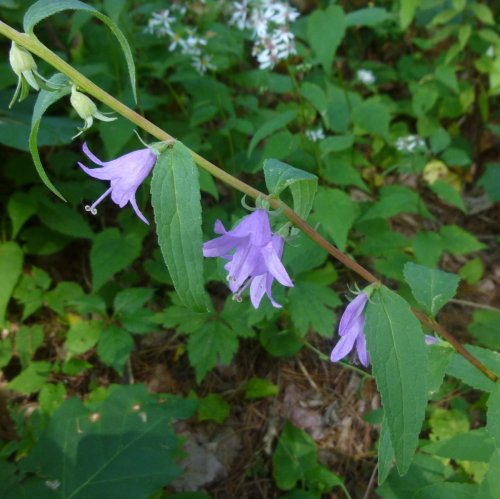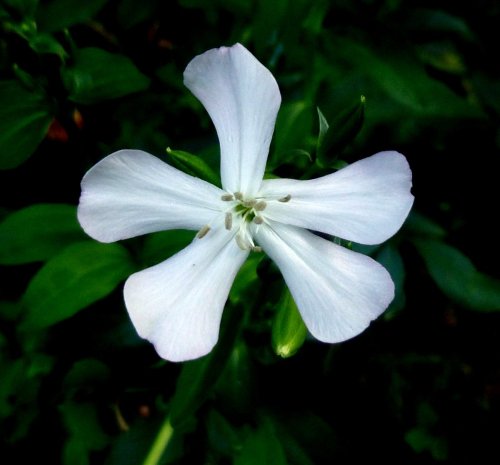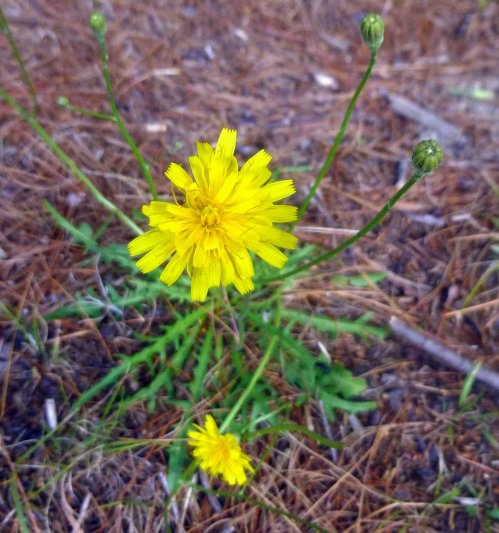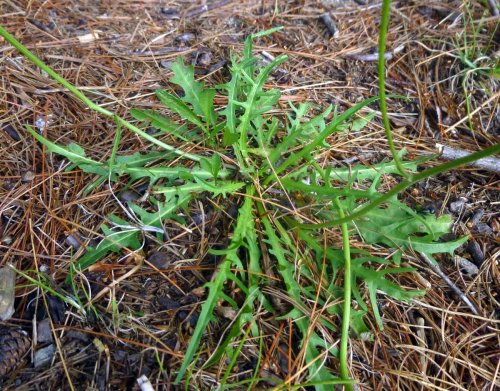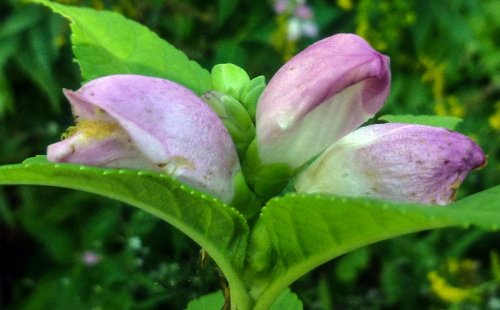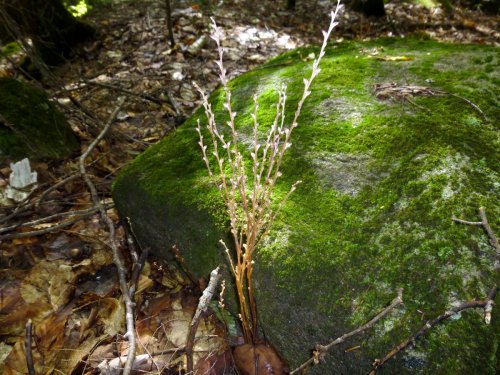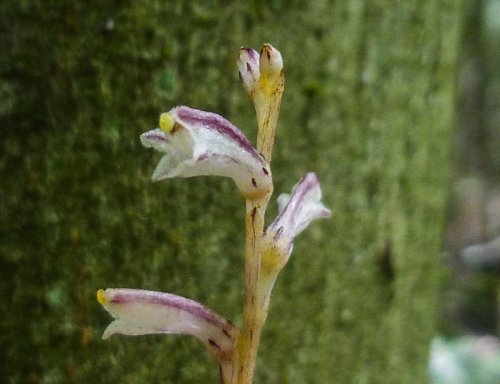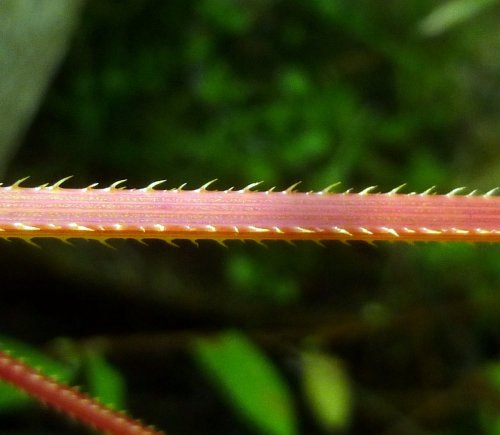Last Saturday in part one of this post I headed south out of Swanzey on a quest to find ledges and deep cuts on the old Cheshire Railroad that once ran from Keene to Fitchburg, Massachusetts, and then on to Boston. Now, in part two of this post I’ve driven south just a short bit and I’m heading north to Keene, simply to cut down on the walking mileage. At this point I haven’t found the deep cut but I’ve seen many other interesting things, like this granite railroad bridge on the southern branch of the Ashuelot River. Built in place with granite hacked out of the nearby hills by railroad stone masons nearly 170 years ago, it’s as solid now as it was then and every bit as impressive too. Most of these arched railroad bridges were laid up dry with no mortar, and that’s quite a feat.
Near the railroad bridge are ruins of old bridge abutments which probably held a wooden or iron highway bridge at one time. Ruins like this are common here because our rivers and streams occasionally rise to “100 year flood” levels and wash everything in their path downstream. In reality it seems like the term 100 year flood should be revised to “10 year flood,” because we’ve had several bad ones in just a few years.
I picked up the trail head just off Route 12 south to Troy but this view looks north into Keene, and that’s where I’m going.
A sign told me exactly where I was but it urged me to go south into Troy and that wasn’t in today’s plan. It reminded me though, that Henry David Thoreau, Ralph Waldo Emerson, Harrison Blake and other transcendentalists rode on the railroad to Troy from Fitchburg, Massachusetts and then hiked to Mount Monadnock to climb it. Thoreau did this four times and wrote extensively of his journeys by rail and his climbs afterwards. He loved Mount Monadnock but even in his day complained that there were too many people on the summit. He would be shocked if he could see it today; some days it’s standing room only up there, and that’s why you never see views from the summit of Monadnock on this blog.
I saw a lot of trailing arbutus growing right along the sides of the trail. This was surprising because the plant was once over collected and is notoriously hard to find. We call it Mayflower and its sweet, spicy scent is unmatched. It was one of my grandmothers favorite flowers, so she was with me along this stretch of trail. I’m going to have to come back in May when it must perfume the air all through here.
I didn’t have to walk too long before I finally found some ledges. I had previously checked out the satellite views of this section of trail and this looked like an area that would have ledges, but even a satellite view isn’t a guarantee because of the heavy tree cover.
The ledges were probably about 20 or 30 feet high; not hugely impressive compared to some I’ve seen. I was a little disappointed by the lack of dripping groundwater. I doubt very much that anything like the tree trunk size ice columns that I see in the Westmoreland deep cut would grow here because it takes a lot of constantly dripping groundwater to create them. They are simply gigantic icicles, after all.
But there must be groundwater seeping in from somewhere because the usual drainage channels along the sides of the rail bed had water in them. Sometimes the color of the rocks makes it hard to tell how wet they are.
We have three or four evergreen ferns here in New Hampshire and the spinulose wood fern (Dryopteris spinulose) seen here is one of them. This lacy fern looks fragile but is actually very tough and will still be green in spring after its long sleep under the snow. I saw many examples of this pretty fern along the trail.
Many ferns release their spores in the fall and if you look at the underside of a fertile frond at that time you will often see small dots called sori. The sori are clusters of spore producing sporangia and they can be naked (uncovered) or capped by a cover called an indusium, as they are on the spinulose wood fern. When the spores are ready to be released thicker cell walls on one side of each sorus will age and dry out, and this creates a tension which causes the cover (indusium) to burst open and release its spores.
This photo shows a single sorus with its cover (indusium) burst, revealing the almost microscopic spherical sporangia. This is as close as I’ve ever gotten to this event. Each sorus is tiny and I can’t even guess the size of the sporangia. I do know that I can’t see them without a macro lens. What I could see if I had a microscope!
At one point on the trail I looked down to the left to the road I had been driving on just a short time before and saw that I was probably what must have been about a hundred feet above it, and it was then that I realized that I was walking on fill. Many thousands of cubic yards of soil must have had to have been used to fill in what was once a small valley between hills. The railroad engineers were smart though and used all the blasted rock from the deep cuts to fill in the low spots. This method is still in use today when a road is built; you bulldoze the top of a hill into a valley to make the roadbed level.
Here is a look down at the aforementioned road. I was almost in the tree tops and had to marvel at such an engineering feat. How they did all this in the mid-1800s is beyond me. It must have been very hard work indeed.
I was surprised to find running ground pine (Lycopodium clavatum) out here because in my experience it is relatively rare in this region. Though it is called running ground pine the plant is a clubmoss and has nothing to do with pines. The “running” part of the common name comes from the way its horizontal underground stems spread or run under the leaf litter. Other names include lamb’s tail, fox tail, wolf’s claw, stag’s horn and witch meal. Native Americans used clubmosses medicinally to treat a variety of ailments including headaches and urinary problems. They were also used to treat wounds and dye fabrics. The Lycopodium part of the scientific names comes from the Greek Lycos, meaning wolf, and podus, meaning foot. Whoever named them obviously thought clubmosses looked like wolf paws, but I don’t really see that.
It wasn’t too long before I saw more ledges, and these looked to be much higher than the first ones.
In fact these were some of the highest I’ve seen in this area. They might have been 60 feet or more at their highest point I’d guess, and I couldn’t back up enough to get all of them in view. Like the first set of ledges I saw these were quite dry with little groundwater seepage, so I’m guessing that I won’t be seeing many of those huge ice columns out here.
This tree was a fallen white pine that fell when it was young. I’d guess 30-40 years old maybe. It’s hard to say how tall it was but it had some height.
Some parts of the ledges were absolutely covered by what at first I thought was moss but which turned out to be liverworts. Many thousands of them.
This isn’t a very good photo because of the shiny wet leaves but I believe that these liverworts were the same greater featherwort (Plagiochila asplenioides) liverworts I saw at 40 foot falls in Surry back in November. These were very wet while the ones at 40 foot falls were on the dry side. They look quite different when wet like these but that’s when they’re at their best. They’re very small.
Again, this is a poor photo but it shows a closer look at the liverwort that I think is greater featherwort. This is only the second time I’ve ever seen them though, so I could be wrong.
Part of the ledge had collapsed and a large rock slide had dammed up the drainage ditch. This isn’t good because the water will eventually flow out into the rail bed and wash it away. I’ve seen the same thing happen on other rail trails, so I hope one of the snowmobile clubs will repair it. It is they who keep these trails open and we who use them owe them a big thank you. If it wasn’t for them in many cases there would be no rail trails. They work very hard to keep them open using their free time and often their own tools, so I’m sure a donation would be welcomed too if you feel so inclined.
The prize for the prettiest thing I saw on this trail has to go to these turkey tail fungi (Trametes versicolor.) They were as beautiful as flowers and some of the most colorful I’ve seen this year.
Well, I didn’t find the great scented liverworts and potential ice columns out here like I hoped I would but I certainly found plenty of other interesting things. I hope you thought so too and I hope this post inspires you to explore the rail trails in your own area.
Our minds, as well as our bodies, have need of the out-of-doors. Our spirits, too, need simple things, elemental things, the sun and the wind and the rain, moonlight and starlight, sunrise and mist and mossy forest trails, the perfumes of dawn and the smell of fresh-turned earth and the ancient music of wind among the trees.~ Edwin Way Teale
Thanks for stopping in.






































